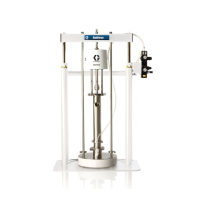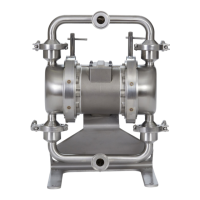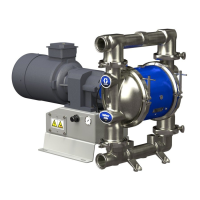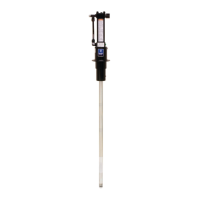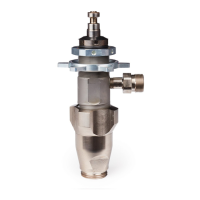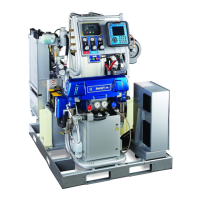Installation
12 3A5999E
Air Exhaust Ventilation
NOTE: The pump exhaust air may contain
contaminants. Ventilate to a remote area if the exhaust
could contaminate your fluid supply.
NOTE: The air exhaust port is 3/4 npt(f). Do not restrict
the air exhaust port. Excessive exhaust restriction can
reduce pump performance.
To provide a remote exhaust:
1. Remove the muffler (M) from the pump air exhaust
port. See FIG. 3.
2. Install a conductive, grounded air exhaust line (N)
and connect the muffler (M) to the other end of the
line. The minimum size for the air exhaust hose is
3/4 in. (19 mm) ID. If a line longer than 15 ft (4.57 m)
is required, use a larger diameter line. Avoid sharp
bends or kinks in the line.
3. Place a conductive, grounded container (P) at the
end of the air exhaust line to catch fluid in case of a
diaphragm rupture. See FIG. 3.
FIG. 3: Venting Exhaust Air
Be sure the system is properly ventilated for your type
of installation. You must vent the exhaust to a safe
place, away from people, animals, food handling
areas, and all sources of ignition when pumping flam-
mable or hazardous fluids. Diaphragm rupture can
cause the fluid being pumped to exhaust with the air.
Place a grounded container at the end of the air
exhaust line to catch the fluid. See FIG. 3.
Key:
A Master air valve (for accessories)
B Air regulator (required, not
supplied)
C Bleed-type master air valve (for
pump) (required, not supplied)
D Air supply line
E Air line coupler
F 1/2 npt (f) pump air inlet
M Muffler
N Grounded air exhaust line
P Grounded container for remote
air exhaust
R Air line filter
P Air pressure gauge (required, not
supplied)

